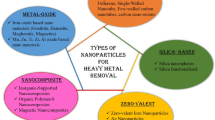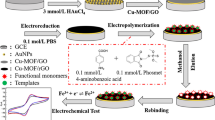Abstract
A sensitive and selective electrochemical sensor based on Au–TiO2 nanoparticles/Chitosan/gold (Au–TiO2 NPs/Chit/gold)-modified electrode was developed for the detection of mercury ions (Hg2+), in which the composite electrode was synthesized via sol–gel method and followed by a self-assembly strategy. The morphology and microstructure of the Au–TiO2 NPs are characterized using transmission electron microscopy and X-ray diffraction. The results demonstrate the presence of a monolayer of well-dispersed Au–TiO2 NPs with an average size of 5–15 nm. The electrochemical properties of the resultant Au–TiO2 NPs/Chit/gold-modified electrode and its response to Hg2+ are studied using cyclic voltammetry and differential pulse anodic stripping voltammetry. The operational parameters that influence the deposition and stripping, such as the supporting electrolytes, pH value, deposition potential and deposition time, are carefully studied. Under optimal conditions, the as-prepared Au–TiO2 NPs/Chit/gold-modified electrode exhibits a wide linear response range of 5.0–400.0 nM with a correlation coefficient of 0.999. In addition, the limit of detection is 1.0 nM with a 240 s preconcentration (S/N = 3), which is lower than the World Health Organization and Environmental Protection Agency limits for Hg2+. The practical application of the proposed method is evaluated in a real water sample, and good results are obtained. This finding is potentially important for electrochemical sensors in environmental applications.






Similar content being viewed by others

References
Peng QM, Guo JX, Zhang QR, Xiang JY, Liu BZ, Zhou AG, Liu RP, Tian YJ (2014) Unique lead adsorption behavior of activated hydroxyl group in two-dimensional titanium carbide. J Am Chem Soc 136:4113–4116
Wang QR, Kim D, Dionysiou DD, Sorial GA, Timberlake D (2004) Sources and remediation for mercury contamination in aquatic systems: a literature review. Environ Pollut 131:323–336
Rajabi HR, Roushani M, Shamsipur M (2013) Development of a highly selective voltammetric sensor for nanomolar detection of mercury ions using glassy carbon electrode modified with a novel ion imprinted polymeric nanobeads and multi-wall carbon nanotubes. J Electroanal Chem 693:16–22
Wu ZC, Jiang LD, Chen HM, Xu HR, Wang XH (2012) Synthesis of folding flake-like CuO sub-microstructure and its application on mercury(II) sensor. J Mater Sci 23:858–864. doi:10.1007/s10854-011-0506-7
Chen D, Hu B, Huang C (2009) Chitosan modified ordered mesoporous silica as micro-column packing materials for on-line flow injection-inductively coupled plasma optical emission spectrometry determination of trace heavy metals in environmental water samples. Talanta 78:491–497
Lee JM, Boyle EA, Echegoyen-Sanz Y, Fitzsimmons JN, Zhang RF, Kayser RA (2011) Analysis of trace metals (Cu, Cd, Pb, and Fe) in seawater using single batch nitrilotriacetate resin extraction and isotope dilution inductively coupled plasma mass spectrometry. Anal Chim Acta 686:93–101
PohL P (2009) Determination of metal content in honey by atomic absorption and emission spectrometries. Trends Anal Chem 28:117–128
Rofouei M, Sabouri M, Ahmadalinezhad A (2011) A solid phase extraction of ultra traces mercury(II) using octadecyl silica membrane disks modified by 1,3-bis(2-ethoxyphenyl)triazene (EPT) ligand and determination by cold vapor atomic absorption spectrometry. J Hazard Mater 192:1358–1363
Gasperi J, Garnaud S, Rocher V, Moilleron R (2008) Priority pollutants in wastewater and combined sewer overflow. Sci Total Environ 407:263–272
Marguí E, Kregsamer P, Hidalgo M, Tapias J, Queralt I, Streli C (2010) Analytical approaches for Hg determination in wastewater samples by means of total reflection X-ray fluorescence spectrometry. Talanta 82:821–827
Safavi A, Farjami E (2011) Construction of a carbon nanocomposite electrode based on amino acids functionalized gold nanoparticles for trace electrochemical detection of mercury. Anal Chim Acta 688:43–48
Cui L, Wu J, Li J, Ge YQ, Ju HG (2014) Electrochemical detection of Cu2+ through Ag nanoparticle assembly regulated by copper-catalyzed oxidation of cysteamine. Biosens Bioelectron 55:272–277
Xu XX, Duan GT, Li Y, Liu GQ, Wang JJ, Zhang HW, Dai ZF, Cai WQ (2014) Fabrication of gold nanoparticles by laser ablation in liquid and their application for simultaneous electrochemical detection of Cd2+, Pb2+, Cu2+, Hg2+. ACS Appl Mater Interfaces 6:65–71
Wen L, Liu B, Zhao X, Nakata K, Fujishima A (2013) Pre-treating sputtered TiO2 film by photoelectrocatalysis to increase the performance of photo-activity and photoinduced hydrophilicity. J Electroanal Chem 688:224–227
Zhang Q, Xu H, Yan W (2012) Fabrication of a composite electrode: CdS decorated Sb–SnO2/TiO2–NTs for efficient photoelectrochemical reactivity. Electrochim Acta 61:64–72
Hosseini MG, Momeni MM (2012) Platinum nanoparticle-decorated TiO2 nanotube arrays as new highly active and non-poisoning catalyst for photo-electrochemical oxidation of galactose. Appl Catal A 427–428:35–42
Primo A, Corma A, Gracia H (2011) Titania supported gold nanoparticles as photocatalyst. Phys Chem Chem Phys 13:886–910
Gan T, Sun JY, He MM, Wang LL (2014) Highly sensitive electrochemical sensor for Sudan I based on graphene decorated with mesoporous TiO2. Ionics 20:89–95
Chanmanee W, de Tacconi NR, Rajeshwar K, Lin WY, Nikiel L, Wampler WA (2012) Photocatalytically generated trimetallic (Pt–Pd–Au/C–TiO2) nanocomposite electrocatalyst. J Electrochem Soc 159:F226–F233
Xing Y, Cai Y, Vukmirovic MB, Zhou WP, Karan H, Wang JX, Adzic RR (2010) Enhancing oxygen reduction reaction activity via Pd–Au alloy sublayer mediation of Pt monolayer electrocatalysts. J Phys Chem Lett 1:3238–3242
Lin C, Song Y, Cao LX, Chen SW (2013) Oxygen reduction catalyzed by Au–TiO2 nanocomposites in alkaline media. ACS Appl Mater Interfaces 5:13305–13311
Wu J, Yang M, Xiao J, Fu XC, Jin JC, Li LG, Chang WG, Xie CG (2013) Gold nanoparticle dropped titania microsphere hybrids as an enhanced sensitive material for stripping voltammetry determination of As(III). J Electrochem Soc 160:B225–B230
Wei M, Liu Y, Gu ZZ, Liu ZD (2011) Electrochemical Detection of catechol on boron-doped diamond electrode modified with Au/TiO2 nanorod composite. J Chin Chem Soc 58:516–521
Tian W, Fan XY, Yang HS, Zhang XB (2010) Preparation of MnO x /TiO2 composites and their properties for catalytic oxidation of chlorobenzene. J Hazard Mater 177:887–891
Xu RX, Yu XY, Gao C, Jing YJ, Han DD, Liu JH, Huang XJ (2013) Non-conductive nanomaterial enhanced electrochemical response in stripping voltammetry: the use of nanostructured magnesium silicate hollow spheres for heavy metal ions detection. Anal Chim Acta 790:31–38
Wei Y, Gao C, Meng FL, Li HH, Wang L, Liu JH, Huang XJ (2012) SnO2/reduced graphene oxide nanocomposite for the simultaneous electrochemical detection of Cadmium(II), Lead(II), Copper(II), and Mercury(II): an interesting favorable mutual interference. J Phys Chem C 116:1034–1041
Gao XH, Wei WZ, Yang L, Guo ML (2006) Carbon nanotubes/poly(1,2-diaminobenzene) nanoporous composite film electrode prepared by multipulse potentiostatic electropolymerisation and its application to determination of trace heavy metal ions. Electroanalysis 18:485–492
Wei Y, Yang R, Liu JH, Huang XJ (2013) Selective detection toward Hg(II) and Pb(II) using polypyrrole/carbonaceous nanospheres modified screen-printed electrode. Electrochim Acta 105:218–223
Miao P, Liu L, Li Y, Li G (2009) A novel electrochemical method to detect mercury(II) ions. Electrochem Commun 11:1904–1907
Zhang Y, Zhao H, Wu ZJ, Xue Y, Zhang XF, He YJ, Li XJ, Yuan ZB (2013) A novel graphene-DNA biosensor for selective detection of mercury ions. Biosens Bioelectron 48:180–187
Sanchez A, Walcarius A (2010) Surfactant-templated sol–gel silica thin films bearing 5-mercapto-1-methyl-tetrazole on carbon electrode for Hg(II) detection. Electrochim Acta 55:4201–4207
Abollino O, Giacomino A, Malandrino M, Marro S, Mentasti E (2009) Voltammetric determination of methylmercury and inorganic mercury with an home made gold nanoparticle electrode. J Appl Electrochem 39:2209–2216
Ordeig O, Banks CE, del Campo J, Muñoz FX, Compton RG (2006) Trace detection of Mercury(II) using gold ultra-microelectrode arrays. Electroanalysis 18:573–578
Acknowledgements
The project was supported by the National Natural Science Foundation of China (No. 21071113), the Natural Science Foundation of Hubei Province (No. 2011CDA049), the International Cooperation Foundation of Hubei Province (No. 2012IHA00201), and the Scientific Innovation Team Project of the Hubei Provincial Department of Education (T201306).
Author information
Authors and Affiliations
Corresponding author
Rights and permissions
About this article
Cite this article
Zhou, L., Xiong, W. & Liu, S. Preparation of a gold electrode modified with Au–TiO2 nanoparticles as an electrochemical sensor for the detection of mercury(II) ions. J Mater Sci 50, 769–776 (2015). https://doi.org/10.1007/s10853-014-8636-y
Received:
Accepted:
Published:
Issue Date:
DOI: https://doi.org/10.1007/s10853-014-8636-y



